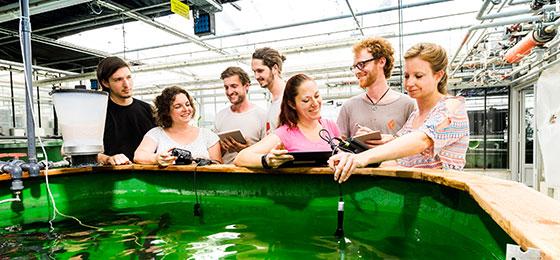From chocolate printing to fish-farming: 12 new BRIDGE Discovery projects

BRIDGE Discovery - a joint funding opportunity offered by the SNSF and Innosuisse - is aimed at researchers with experience in basic and applied research, with a view to realising the innovation potential of research findings.
BRIDGE Discovery - a joint funding opportunity offered by the SNSF and Innosuisse - is aimed at researchers with experience in basic and applied research, with a view to realising the innovation potential of research findings.
In the context of this second call, a panel composed of experts in applied research and in the implementation of scientific results evaluated 87 proposals in a two-stage process. After the first round of evaluation, 26 researchers were invited to continue to the second level - a presentation of the project and subsequent interview. Based on the evaluation, 12 outstanding projects have been awarded an overall amount of CHF 16.1 million, corresponding to a success rate of 14% for the call. The projects will be funded by the SNSF and Innosuisse. To ensure support for as many excellent projects as possible, the SNSF exceptionally allocated additional funds to the available BRIDGE budget.
Successful universities of applied sciences
The projects are devoted to topics ranging from the life sciences to engineering and information & communication technologies. Particularly encouraging are the remarkable increase in teams from universities of applied sciences and the grants won by female principal investigators.
The funded applicants include, for example, Tobias Delbruck’s team from the University of Zurich in collaboration with the Centre Suisse d'Electronique et de Microtechnique (CSEM). They are working together to engineer ultra-low power intelligent systems for automatic real-time visual detection. This will facilitate the development of applications such as automatic fall detection systems for elderly people, smart white canes to assist blind people or smarter robot vacuum cleaners.
Also successful were Erich J. Windhab and his team from ETH Zurich and Bern University of Applied Sciences (BFH). They are developing sophisticated 3D printing technologies for the food industry. The innovations will allow chocolate confectionary businesses to implement faster printing processes. Moreover, confectioners will be able to reduce the amounts of expensive aroma or nutritionally non-desirable ingredients in chocolates or pralines, thereby maximising sensory experience.
Another exemplary awardee is Constanze Pietsch. With her team at Zurich University of Applied Sciences (ZHAW) she is developing innovative tools and processes to measure stress in fish for better on-farm management and for status checks by governmental agencies.
Latest call for proposals
The third call for BRIDGE Discovery was launched in December 2018. Researchers can submit a letter of intent until 18 February 2019 and a project proposal until 8 April 2019. In all cases, a letter of intent must be submitted ahead of the project proposal.
The following twelve projects from the second call will be funded:
- Rebecca Buller (ZHAW), Vincent Perreten (UNIBE), Rémy Bruggmann (UNIBE):Microbial Epimerases: A Toolbox for the Synthesis of Novel Peptide-Based Drugs
- Tobias Delbruck (UZH), Pierre-François Rüedi (CSEM):VIPS: ultra-low power Visual Perception SystemUrsula Keller (ETHZ):Dual-comb spectroscopy based on dual-comb-modelocked diode-pumped solid-state lasers
- Georg Lipps (FHNW), Georgios Imanidis (FHNW):Efficient Colonic Drug Delivery
- Bradley Nelson (ETHZ), Dario Floreano (EPFL), Joris Pascal (FHNW):A submillimeter Minimally Invasive System for Cardiac Arrhythmia Ablations
- Yves Perriard (EPFL), Zoltan Pataky (HUG):Intelligent Footwear for Prevention of Lower Extremity Amputations in Diabetic Patients
- Constanze Pietsch (ZHAW), Theo H.M. Smits (ZHAW):Fish Welfare Assessment (FiWeA) – Development of Innovative Tools for the Field
- Klaas Pruessmann (UZH), Thomas Burger (ETHZ), Klaas Enno Stephan (UZH):Wireless Sensing and Real-Time Correction of Head Motion in MRI
- Jean-Charles Sanchez (UNIGE), Philippe Passeraub (HES-SO), Marc Emil Pfeifer (HES-SO):“TBI-Dx”: Traumatic Brain Injury Point-of-Care Multiplex in vitro Diagnostic Device
- Emma Slack (ETHZ), Markus Aebi (ETHZ), Martin Bachmann (UNIBE):Self-assembling glycoprotein nanoparticle vaccines
- Erich J. Windhab (ETHZ), Christoph Denkel (BFH), Karl-Heinz Selbmann (BFH):Industrially relevant Synchronous Multiscale 3D-Printing Process (SYMUS-PD3) for the fast manufacture of tailored texturized and sensory/nutrition-functionalized food systems
- Ursula Wolf (UNIBE), Guido Piai (EMPA), Luciano Fernandes Boesel (NTB):Wearable textile sensor to protect against pressure ulcers – ProTex